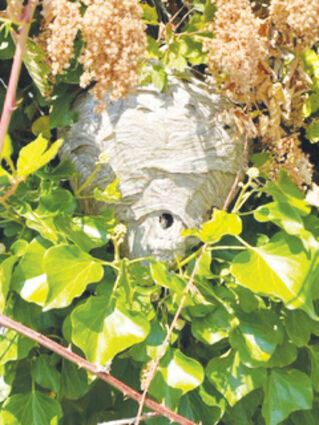Orchid wasps, grasshoppers, Vaux's swifts and honey bees
October 12, 2022

Jacque Chase
WASP LOCAL HOUSING – Did you see this paper wasp's nest in September on the west side of Whatcom Street?
There was some interesting action on the dike path at Hayton Farms Game Range at summer's end. The large territorial grasshoppers have been digging holes to lay eggs in the top gravel. This has drawn in large orchid wasps which was interested in parasitizing the grasshopper eggs and larva.
The wasps were searching the area for covered nest holes. They are large wasps with long needle-like ovipositor attached to the back of their abdomens. They penetrate the prey and lays an egg inside of its victim. The egg hatches and a wasp larva lunches on the host until its ready to hatch. The ground had several adult wasps searching for nest holes. The adults search with their antenna which are good at smelling for covered holes.
Recently on television news the public has become aware of the migratory Vaux's swift. There is an old school in the local Marysville area that still has the large standing chimney that was common early in the last century. This is an original chimney with slick internal sidewalls. Before chimney fires were common, several hundred or even thousands of birds would spend the night inside this structure sleeping attached to the walls.
Houses built in the first half of the last century had nesting swifts because people did not use the fireplace in the summer. This area supported countless numbers of swifts and their kids, but not anymore. Now these birds nest in stumps or hollow snags.
Over 30 years ago in spring I was traveling in northeastern Washington. One evening I noticed several thousand swift dropping down in a vortex into a large school chimney. It took several minutes for them to all go into the chimney where they spent the night.

Another spring I was in the woods. There was a large cottonwood tree with a cavity containing a hive of wild honey bees. Nesting inside with the bees and above the cones was a pair of Vaux's swift. They had no better protection to keep out predators like squirrels from robbing their nest.
I have not seen a Vaux's swift this year but they still summer in woods at higher elevations.
A new problem for me at Wylie Game Range is that the existing dikes I walk on are being raised two feet because they were installed too low and tidal surge is going over the top. In the last year or so, high water has eroded the tops. Raising the dike only two feet is a temporary solution. The 100-yard-high flood tide may be a foot or two above the new dike. If you check the history on the Fir Island dike, it has been rebuilt many times and never permanently. The road was closed to the parking lots through September, so I have started hiking there again. With climate change on the way, living on Fir Island may be somewhat risky.





Reader Comments(0)